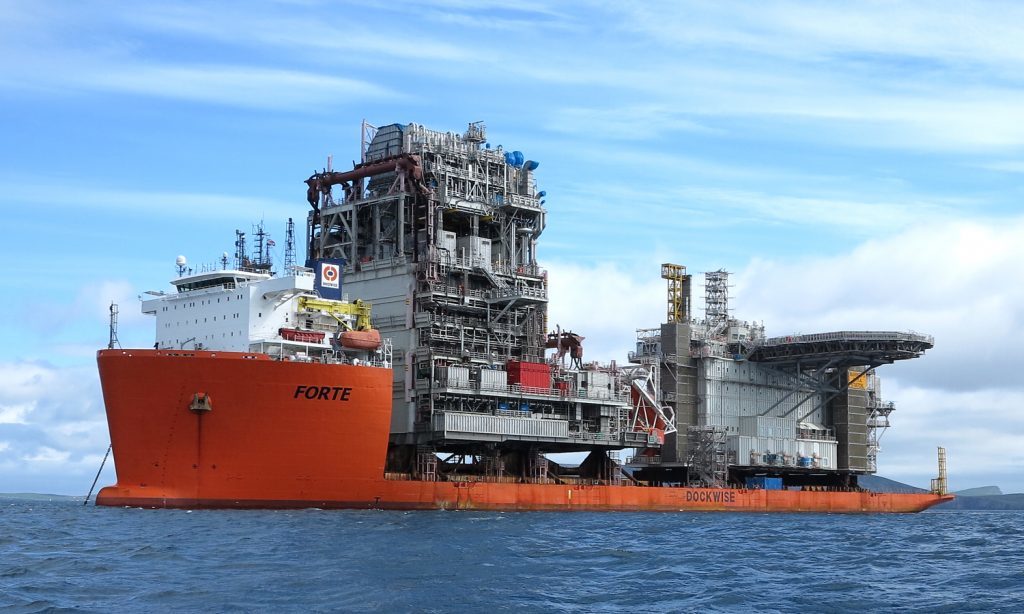
Statoil’s UK boss today renewed its commitment to the North Sea for the next 30 years, hailing the region’s “positive and exciting” future.
The Norwegian operator will start its milestone heavy lift operations for its flagship Mariner Development this week, paving the way for the creation of 1500 North Sea jobs.
The Mariner field is located approximately 95 miles (150 kilometres) east of Shetland. Its development adds 250 million barrels of oil to the basin’s output.
Hedda Felin, Statoil’s senior vice president UK & Ireland offshore, said: “We believe in the North Sea and are looking forward to bringing Mariner on stream in 2018, with the on-going ripple effects a development like this creates, and continuing to explore for new opportunities. We also look forward to seeing the progress of our Hywind development, the world’s first floating wind park offshore Peterhead. It’s an exciting time for Statoil in the UK.”
The 1500 jobs are linked to the hook-up and commissioning of Mariner, which starts this summer. The work is expected to last 18 months. The jobs, which are being sourced by Aker, include 800 offshore at peak levels of activity. An additional 700 permanent jobs will be supported by Mariner onshore and offshore.
David Clark, Aker Solutions’ UK country manager and EVP for services, said: “Investment in the Mariner development is important for the future of the UK’s oil and gas industry.
“A development of this scale brings a welcome period of recruitment activity as we seek to employ up to 1,500 onshore and offshore personnel. Aker Solutions is proud to partner with our customer, Statoil, in the hook-up and commissioning phase of the project.”
Andy Samuel, chief executive of the Oil and Gas Authority, said: “Mariner is an important development which is expected to have a long production life and contribute significantly to MER UK. We welcome the ramp-up in activity during the hook up and commission phase and the jobs secured as a result.”
Mariner, which has a 30-year lifespan, will produce 55,000 barrels a day when it comes on stream in the second half of 2018.
The field was first discovered in 1981, but it took decades for the industry to work out how to make it viable.
Success came in the form of Statoil’s entrance to the UK North Sea.
Hedda said: “Statoil was able to make the Mariner development possible through the use of the new seismic technology, which our geoscientists used to develop a much clearer picture of the reservoir than had ever previously been possible. The application of innovative technical solutions developed by our teams enables us to produce the heavy oil in an efficient way.”
Deirdre Michie, chief executive of Oil and Gas UK, welcomed the news.
She said: “This is great news for the highly skilled people working in our industry and demonstrates yet again the positive future of the basin. To ensure that other ambitious projects like Statoil’s Mariner field development can proceed on the UK Continental Shelf, our focus must remain on improving efficiency and attracting fresh investment into the basin in order to sustain the hundreds of thousands of jobs our sector still supports.”
A vessel carrying the first of the Mariner topside modules has arrived off the coast of Shetland, having completed an 11,300-nautical mile journey from South Korea.
Eight modules and a flare boom, weighing around 38,000 tonnes in total, were ferried by five heavy transport vessels to the UK North Sea. The modules will be held on the vessels in a sheltered area near Lerwick, in preparation for the start-up of the installation operations. This week, one of the world’s largest heavy lift vessels, the Saipem 7000, will lift the modules on to the steel jacket which was installed in the field in 2015.
Hedda added: “The Mariner investment decision was made in 2012 and will create wider ripple effects in the supply chain for the next thirty years. We are privileged to be able to grow and contribute towards the longevity of the UKCS. Mariner demonstrates that this industry has a positive and exciting future ahead.”
The North Sea’s exciting future includes nurturing a diverse energy mix, according the Statoil boss.
The firm is currently developing the world’s first floating wind farm dubbed Hywind.
The five turbines constituting the Hywind pilot park will start production off the coast of Peterhead this autumn.
“The transfer of Statoil’s oil and gas expertise and technology into the renewables arena has contributed greatly to the development of the Hywind floating turbine concept. Many of our teams onshore in Aberdeen work with both the upstream and renewables business areas,” Hedda said.
“The same heavy lift vessel, the Saipem 7000, will be used for the installation of the Hywind turbines and the Mariner topside modules this summer.
“To meet future demand we will continue to need the full energy mix. Renewables are growing faster than anyone forecast, but oil and gas will still be dominant. We are proud to have the full energy mix in our UK portfolio, with our activities in offshore wind, oil and gas.”
Work for both flagship projects will be carried out this summer.
The operator also has plans to drill three new North Sea exploration wells in the next three months.
Hedda added: “Statoil has a long-term perspective on the UK North Sea. We have invested in the 30-year Mariner development as well as the cross-border Utgard field, which ties back stranded reserves through existing North Sea infrastructure, and we will continue to explore in the hope of finding new discoveries.”
For more details on Statoil’s landmark heavylift read page two in this month’s Energy.
Recommended for you
